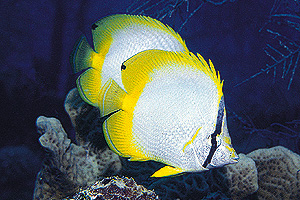Talking Fish: Wide Variety Of Sounds Discovered
(excerpts from an article by Charles Q. Choi, LiveScience)
Scientists are discovering unusual mechanisms by which fish make and hear secret whispers, grunts and thumps to attract mates and ward off the enemy. In one bizarre instance, seahorses create clicks by tossing their heads. They snap the rear edge of their skulls against their star-shaped bony crests.
There are more than 25,000 species of fish living today, more kinds than any other animal form with a backbone in the history of the planet. A lot of them appeared to have done well in school.

"We know so far that at least 1,000 fish species make sounds, with a huge diversity of means by which they generate and listen to sounds," fish behaviorist Timothy Tricas at the University of Hawaii at Manoa said.
Tricas and his colleagues studied butterflyfishes, a family that includes 126 species with bright colors and striking patterns found on just about every coral reef in the world. Using underwater cameras and sound recorders known as hydrophones on Hawaiian coral reefs, Tricas and his colleagues discovered butterflyfish emitted several types of sounds using tail slaps, fin flicks, fin spine extensions, grunts and jumps.
"We know butterflyfish swim very close together," Tricas said. "What we think might be happening is they are essentially whispering, and have to swim close together to listen."
A fish that other scientists have recently investigated is the pearlfish. Curiously, these dwell inside living sea stars or tubular creatures known as sea cucumbers. While a number of fish, such as the toadfish, communicate with their swim bladders by rapidly twitching it back and forth with muscles, the pearlfish instead use a much slower muscle that generates strong, low frequency sounds which pearlfish may use to speak with others, advertising their presence even from inside their homes.
"Think of the pearlfish swim bladder as a bongo drum. If you could grab its skin and let it go like a rubber band to go thunk, that's what the pearlfish is doing, some four to 20 times per second," Tricas said. "It's a highly novel system that I've never heard of anything like before."
Studying fish sounds could help shed light on the evolution of communication and hearing, as well as related behaviors, such as finding of mates or defending of territory, Tricas said. For instance, the fact that butterflyfish can effectively only whisper "may help explain the evolution of their pairing behavior, why the fish appear so social, and why almost all butterflyfish affiliate with one another so often."
Currently the purposes of some fish sounds remain complete mysteries. "There were early claims that seahorse clicking increased in intensity during courtship, but no evidence has been found to support that. It's a tantalizing question for scientists to work on," said marine conservationist Amanda Vincent, director of Project Seahorse in Vancouver.
 Hello everyone, I just wanted to introduce myself as the newest addition to Buffalo Niagara Riverkeeper. My name is Chris Murawski and I will be serving an internship with the organization for the Spring 2007 semester. I am currently working on an undergrad degree in Biology at Buffalo State College and plan on graduating this May. My duties as an intern include working with Robbyn on the Riverwatch program, assisting with the Spring Cleanup, and various other tasks.
Hello everyone, I just wanted to introduce myself as the newest addition to Buffalo Niagara Riverkeeper. My name is Chris Murawski and I will be serving an internship with the organization for the Spring 2007 semester. I am currently working on an undergrad degree in Biology at Buffalo State College and plan on graduating this May. My duties as an intern include working with Robbyn on the Riverwatch program, assisting with the Spring Cleanup, and various other tasks. 
